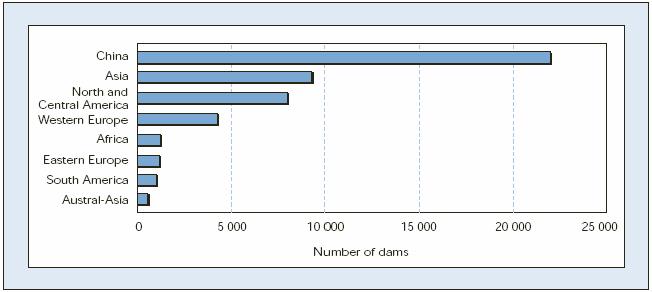1.3 The Significance of Large Scale Dam Building
The World Scenario of Dam Building
Water-retaining structures, mostly in the form of dams, are indispensable in the development of hydropower to serve the purposes of domestic, agricultural and industrial consumption. As long as 3,000 years ago in the Fertile Crescent (WCD, 2000), people started dam construction in rivers and streams, not only for the primary purpose of retaining potable water, but also for controlling floods, irrigating farmlands, and for allowing or improving navigation. The most early river engineering took place in Mesopotamia, dating back to more than 8,000 years ago (Norman, 1971). The earliest known water storage dam is located in Jawa, Jordan, and dates back to at least 3000 BC (WCD, 2000). This gravity structure was a 9-meter high dam, with a 1-meter-wide stone wall, supported by a 50-meter-wide earth rampart (Norman, 1971; WCD, 2000). The ancient Egyptians, Romanians, Chinese, and Iranians have also been well known for building different types of dams, some of which are still surviving and being utilized in modern days (Morman, 1971). As science and technology advanced, especially after the industrial revolution, the utility and level of the technology for generating power from water movement greatly improved. This being so, it became possible for humans to construct large and more complex dams as a primary way to collect potable water and to use its flow to produce energy. According to the International Commission on Large Dams (ICOLD, 1998), by the end of 20th century, about 47,000 large dams and 800,000 small dams have been constructed worldwide. Statistics show that 30 to 40 percent of the 271 million hectares of irrigated land worldwide relies on dams (Rosenberg et al., 1997; WCD, 2000) and they supply 20 percent of the world’s total electricity, with over 63 percent of renewable energy (ICOLD, 1998; WCD, 2000). Virtually all of the largest dams were built in the last 35 years (WCD, 2000). In the year 2000, approximately, a further 1,600 dams are currently under construction in over 40 countries (ibid). Nearly half of the rivers in the world now house at least one large dam (ibid). Figure 1-14 shows a regional distribution of large dams worldwide. It can be seen from the chart that over half of all large dams (more than 22,000) are in China, with the United States having built the second greatest number. India has now become the third largest dam construction site in the world, with over 3,000 large dams (ibid). The important role that China plays by way of providing technological templates for the international dam building community is illustrated by Figure 1-15, below.

Figure 1-14: Regional distribution of large dams worldwide
(Source: WCD estimates, based on ICOLD and other sources)

Figure 1-15: Regional distribution of large dams in 2000
(Source: Report of the WCD, 2000, p.8)
The Chinese Scenario of Dam Building: A Historical Review
China has an impressive history of dam building. The most ancient reservoir, Shaopi, built in Eastern Zhou Dynasty (598-591BC) in Anhui Province, was a 10-meter-high earth dam, and has been in regular operation up until now (Zhang 1999). Followed by the Zhibo irrigation canal built around 453BC in Shanxi Province (ibid). The famous Dujiangyan dam, located in Sichuan Province, a 2,200-years-old, 3.8-meter-high innovative masonry spillway dam is currently still working well and irrigates some 800,000 hectares of farmland (McCully, 2001; Zhang & Hu, 2006).
In order to develop water resources and maximally control flood problems, and where possible improve navigation, more than 86,000 dams in total (among them more than 22,000 are large dams) have been currently under operation in China. More than 85 percent of dams in China have been built since 1949, the year of the establishment of the People’s Republic (Ponseti & López-Pujol, 2006). Prior to 1949, in comparison, there were only 22 large dams in service with an installed hydropower capacity of 163 million watts (Fuggle & Smith, 2000; Ponseti & López-Pujol, 2006). Despite the huge number of dams now existing in China, it is reported that China is enthusiastically committed to building more dams in China because, as a government official claimed, only one-third of water resources in China have been exploited (Dai, 1998).
